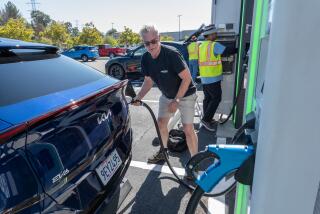Plugged In to the Future : Man Builds Himself an Electric Car
- Share via
SAN DIEGO — My, how times and styles have changed for Gary Klein.
Once, he thundered around town in a flashy ’49 Ford. Metallic green. Lowered. Dual exhaust pipes that rumbled and fired like Judgment Day. He was 16.
Now, Klein is a middle-aged, seasoned and sensible bureaucrat for Caltrans in San Diego who wears short-sleeve shirts and has a pocket full of pens.
These days his commute-to-work car is a hopelessly tame 1981 Ford Escort station wagon. Bunny white. Hates most hills. Runs as quiet as a coroner’s office.
What’s gotten into Klein?
Electricity.
Klein has become convinced that the most effective way to reduce smog is by casting off traditional combustion engine vehicles and going wholesale to electric cars. Like his.
“I don’t consider myself a hard-core environmentalist, but I feel I’m doing something to clean up the air,” said Klein, who oversees a number of local highway projects for the state transportation agency.
For 25 years, he had this current going through his head about electric cars, and last year, he bought converter parts, acquired a junker Ford Escort with a blown engine, and, after putting in 250 hours of labor, last November came up with the future.
Klein’s car is powered by 18 six-volt batteries that run a traction motor and produce about 100 horsepower, enough to get up 65 m.p.h. for Klein’s daily round-trip trek from his El Cajon home to Caltrans in San Diego’s Old Town.
Call his electric car a wimp in the heartland of testosterone-driven ‘Vettes and Trans Ams, but the vehicle is roadworthy, powerful enough, and rides with stealth-like silence (except for a few old body rattles) that surrounds Klein with serenity while he drives.
“I love it. It’s a different sensation,” he said.
And, like it or not, it will not be long before thousands of motorists join him.
The latest figures from the state Department of Motor Vehicles show only 3,095 registered electric automobiles in California. The state Air Resources Board, which sets the strictest anti-smog standards in the nation, has decreed that in 1998, 2% of all new cars sold in California must be electric powered. By 2003, the figure would reach 10%, or an estimated 100,000 electric autos a year.
“Over its road life, an electric car can be 100% less polluting than a gas car,” said air board spokesman Bill Sessa. “Every major (automobile) manufacturer has electric prototypes.”
Klein studied electric cars for 25 years before deciding the time had arrived to set an example.
Although it is possible to buy a complete electric car outright, he opted to purchase the vital organs from a company in Santa Rosa and convert the Escort he acquired for his automotive Frankenstein experiment.
He removed, among other things, the engine, radiator, pipes, gas tank and catalytic converter from the station wagon. By the time he finished the conversion, the project had cost $9,000--including $500 to buy the junker and paint it.
Although a car can be a distracting mistress, Klein’s wife of 32 years, Barbara, supported her husband’s quest. “She agreed that if an energy crisis ever came again, we needed to do something,” Klein said.
The Ford is quiet, smooth, never needs a gas station, and has a 40- to 70-mile range--depending on speed and hills--before it needs a battery recharge. It does not overheat because there is no radiator.
The car’s capabilities are perfect for Klein, who drives only 15 miles to work, where he plugs the car’s battery charger into a 110-volt outlet. When the car completely runs down, it takes eight or nine hours to recharge.
“Once every three months I check the water in the batteries. Period,” Klein said. Also, his 18 six-volt batteries must be replaced every three years, a $1,300 expense--which Klein figures is about equal to the cost of buying gasoline for a conventional car. The big savings, he said, is in the lack of maintenance needed for an electric auto.
Klein is not shy about his car, even going so far as to put a sign on the back: “Electric Vehicle.”
“When people see me driving 65 (m.p.h.) down the freeway and see that sign, they’ll think maybe electric cars aren’t that bad.”
After eight months behind the wheel, “I keep thinking the novelty will wear off, but it doesn’t. I enjoy going to work in the morning,” Klein said.






